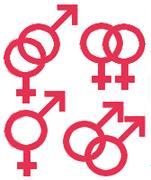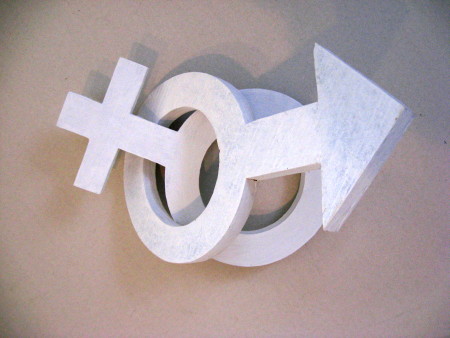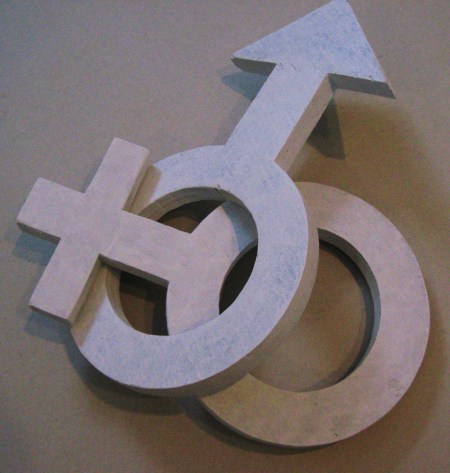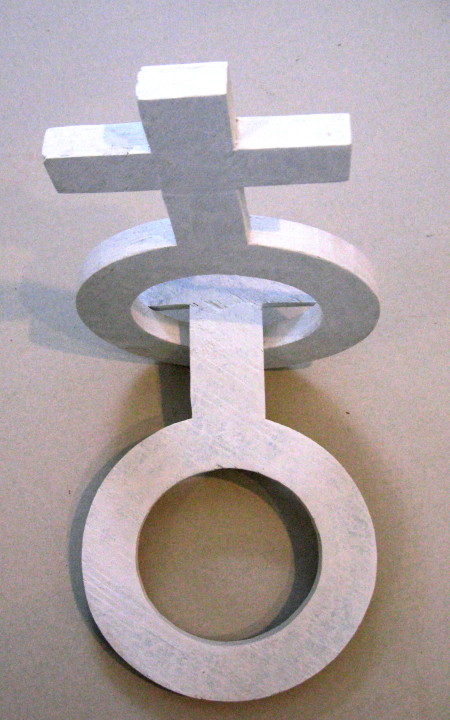
This diagram, taken from the web, depicts configurations of the classic male and female symbols in relationships befitting gender orientations. Three of the four portray affinities through linked circles. It is unclear in most such diagrams whether the circles are as chains or merely superimposed. I have created models, with a third dimension added, that inter penetrate, arrow and cross, through circles.

You will recognize the customary gender symbols: a cross on a circle for the female and an arrow on a circle for the male. There is much to explore and to negotiate with these items. First, the very shapes beg further research as I am following this idea with nary a notion of their respective backgrounds. I have seen them associated with astrology and alchemy, so I would assume them quite old. The male symbol represents the planet Mars and the arrow has an anatomical reference. The female symbol represents the planet Venus but the sites I visited didn’t explain the cross shape, except to also declare it anatomical. As a graphic the arrow points upward to a two O’clock position while the cross points downward. These orientations are freed up when in three dimensions, and lead to a range of interpretations.

I have kept it simple for the sake of this post. But interpretive potential increases with changing colors and patterns, sizes and proportions, numbers of units and their relative orientations. Colors can indicate emotions, affiliations, etc., sizes and proportions can indicate relative importance, deviations from a norm and elements can be organized to tell stories. All that and more.

I must admit that the shapes are evocative; especially when they are free to penetrate each other. You get all the issues like who’s on top, who’s got the bigger one. But in keeping with the sedate tenor of this site we will refrain from pursuing this side of the matter – right? But there is a lot to discuss here and I would like to hear whatever comments that these images engender.

What is the difference between the top left and bottom left designs in the first image? Is one straight and the other bisexual? Please enlighten me.
Katie:
It would seem, from a cursory perusal, that the upper left is a gender alliance and the bottom represents bisexuality.
Good question, Katie. While waiting for Jay, my interpretation would be that upper left represents a heterosexual couple, while lower left is a single bi person.
Jay, I note that taking these symbols 3D means that it’s impossible for a joined pair to be in the same plane. Unless that circle of common humanity is made wavy enough to accomodate closer contact. Which would probably be more accurate, in some sense.
There seems no need to limit yourself to the stories you can tell with only two elements. The direct symbolism brings huge power to your chains. Nets are next.
Our comments crossed — how fitting.
Sorry to interrupt (frequent lurker, rare commenter), but I believe that the lower left symbol represents a transgender or intersex individual.
The female symbol is traditionally explained as depicting the hand mirror of the goddess Venus; the male symbol the shield and spear of the god Mars (although obviously the spear has phallic significance).
Break the woman to make it fit?
Steve:
The thought plickens. Good observation. sounds topological, but it would indeed appear that three dimensional objects cannot occupy a common plane, unless that plane is applied and portions of the objects, rather than their entireties, occupy it. But then an infinity of such planes can be made to pass through such objects. Something lost, something gained.
There’s an entire realm of speculation awaiting around two versus three dimensional identities. A neon canned sign on a storefront is necessarily three dimensional in an asymmetrical way, but its message commonly registers as two dimensional relative to the plane of the storefront. These little wooden symbols of mine are meant to be free from any embedded state and to enjoy whatever options so accord. However, if they are photographed and processed to appear as cutouts against a neutral background, and without any visual cues like shadows, then we come back to your point. The gender symbols cannot be kept down on the form after they’ve seen 3-d. The various fore-shortenings as seen in silhouette allude to specific actions or forces at work. Moreover, humanity is served by the very fact of the symbols which reflect human conditions rather than sex as a biological entity.
D.
I’m not sure that I catch your meaning. If physical fracture is at issue, then I must say that I had cut the head off the arrow in the mistaken belief that it was necessary to get it through the circle. Not so in either case as cross and arrow both could be insinuated by way of a sideways maneuver.
Helquin:
Thanks for the info.
I find it interesting that these gender symbols are alive and well in these times. Mars? Venus? Masculine power vs. feminine beauty? What would be the symbols for a domesticated male, and for a female gladiator – neither of them trans-sexual, but behaviorally trans-gendered after whatever manner?
Hermaphrodites copulate “69” suggesting excitatory reverberations among female and male sex neurons in their Itsy Bitsy Teenie Weenie invertebrate ganglia.
Birgit:
If one could imagine Itsy Bitsy Teenie Weenie Invertebrate Bikinis. What does “69” mean in terms of such creatures? Do they assume some sort of numerical configuration: do they do a number on themselves? Old artists need to know.
Pictures show paired, intertwined numerical configurations.
Until tomorrow, retreating back into a cloistered space – no cell phones, landlines, wireless, TV, radio.
Jay — According to G.D. Schott’s “Sex Symbols Ancient and Modern: Their Origins and Iconography on the Pedigree” (2005) the two symbols originated in astrology/astronomy. From there they passed to alchemy (Venus=copper; Mars=iron), and then to chemistry and pharmacy. In the 18th Century, Linnaeus introduced the symbols to botany, copying them from a 17th-century pharmacy text (where they were used to indicate male & female flowers), and only afterwards did they came to be used in zoology, human biology and genetics.
Given that Linnaeus explains he adopted the symbols merely “for reasons of economy in recording,” the associations of feminine beauty and masculine power may well have been beside the point even in his era — much as the original associations of our alphabetic characters are far removed from their present-day usage. Linnaeus was just borrowing two characters for which there was already a precedent for indicating the two sexes.
There’s another article on the subject, by William T. Stearn (“The Origin of the Male and Female Symbols of Biology,” 1962) but it’s not available free online. Damn JSTOR anyway…
Helquin:
Thanks for going to all of this trouble. I’m writing this all down in my Mead notebook.